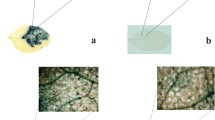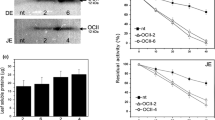Summary
To determine the degree of insect resistance in transgenic plants, different bioassays are used which typically use either whole plant or small pieces of leaves or stems of transgenic plants, following culture under greenhouse conditions. An in vitro insect-feeding bioassay is presented which permits the infestation of transgenic plantlets with newly hatched larvae from the striped stem borer. The bioassay consists of the germination of rice seeds in vitro using Murashige and Skoog medium in test tubes, and then infestation of each 3–4 cm long seedling with one neonate larva obtained from surfacesterilized eggs of Chilo suppressalis. The infested in vitro plantlets are kept in culture rooms at 25°C for several days and then the seedling damage and the growth of the larvae are analyzed. Senia (japonica variety) homozygous transgenic rice plants were used for these experiments. The plants were transformed with either the cry1B or the maize proteinase inhibitor (mpi) genes. Both genes confer resistance to Chilo suppressalis. With non-transformed plants the larvae grew and developed normally, feeding on the small rice plantlets. In contrast, with cry1B plants, the neonate larvae died during the first days of the infestation. These plantlets recovered completely and developed similarly to the non-infested control plants. With transgenic plants transformed with the mpi gene, the neonate larvae did not die but grew more slowly compared with the controls. Thus, this in vitro insect-feeding bioassay is a rapid and easy method to detect the resistance of cry and mpi transgenic plants to stem borers such as Chilo suppressalis.
Similar content being viewed by others
References
Alam, M. F.; Datta, K.; Abrigo, E.; Oliva, N.; Tu, J.; Virmani, S. S.; Datta, S. K. Transgenic insect-resistant maintainer line (IR68899B) for improvement of hybrid rice. Plant Cell Rep. 18:572–575; 1999.
Breitler, J. C.; Marfà, V.; Royer, M.; Meynard, D.; Vassal, J. M.; Vercambre, B.; Frutos, R.; Messeguer, J.; Gabarra, R.; Guiderdoni, E. Expression of a Bacillus thuringiensis cry1B synthetic gene protects mediterranean rice against the striped stem borer. Plant Cell Rep. 19:1195–1202; 2000.
Cheng, X.; Sardana, R.; Kaplan, H.; Altosaar, I. Agrobacterium transformed rice plants expressing cry1Ab and cry1Ac genes are highly toxic to striped stem borer and yellow stem borer. Proc. Natl Acad. Sci. USA 95:2767–2772; 1998.
Christensen, A.; Quail, P. H. Ubiquitin promoter-based vectors for high level expression of selectable and/or screenable marker genes in monocotyledonous plants. Transgen. Res. 5:213–218; 1995.
Cordero, M. J.; Raventos, D.; San Segundo, B. Expression of a maize proteinase inhibitor gene is induced in responses to wounding and fungal infection. Systemic wound-response of a monocot gene. Plant J. 6:141–150; 1994.
Datta, K.; Vasquez, A.; Tu, T.; Torrizo, L.; Alam, M. F.; Oliva, N.; Abrigo, E.; Khish, G. S.; Datta, S. K. Constitutive and tissue specific differential expression of the cry1Ab gene in transgenic rice plants conferring resistance to rice insect pest. Theor. Appl. Genet. 97:20–30; 1998.
Ghareyazie, B.; Alinia, F.; Menguito, C. A.; Rubia, L. G.; de Palma, J. M.; Liwanag, E. A.; Cohen, M. B.; Khush, G. S.; Bennet, J. Enhanced resistance to two stem borers in an aromatic rice containing a synthetic cry1Ab gene. Molec. Breed. 3:401–404; 1997.
Kota, M.; Daniell, H.; Varma, S.; Garczynski, S. F.; Gould, F.; Moar, W. J. Overexpression of the Bt cry 2Aa2 protein in chloroplasts confers resistance to plants against susceptible and Bt-resistance insects. Proc. Natl Acad. Sci. USA 96:1840–1845; 1999.
Maqbool, S. B.; Husnain, T.; Riazuddin, S.; Masson, L.; Christou, P. Effective control of yellow stem borer and rice leaf folder in transgenic rice indica varieties Basmati 370 and M7 using the novel delta endotoxin cry2A Bt gene. Molec. Breed. 4:501–507; 1998.
Marfà, V.; Melé, E.; Gabarra, R.; Vassal, J.M.; Guiderdoni, E.; Messeguer, J. Transgenic spanish rice plants (Senia) with the cry1B gene are resistant against striped stem borer (Chilo suppressalis) during the vegetative and reproductive stages of the plant. Plant Cell Rep. 20 (in press) 2002.
Melé, E.; Messeguer, J.; Gabarra, R.; Tomas, J.; Coll, J.; Camps, F. In vitro bioassay for the effects of Ajuga reptans phytoecdysteroids on Trialeurodes vaporarioum larval development. Entomol. Exper. Applic. 62:163–168; 1992.
Mochizuki, A.; Nishizawa, Y.; Onodera, H.; Tabei, Y.; Toki, S.; Habu, Y.; Ugaki, M.; Ohashi, Y. Transgenic rice plants expressing a trypsin inhibitor are resistant against rice stem borers Chilo suppressalis. Entomol. Exper. Applic. 93:173–178; 1999.
Murashige, T.; Skoog, F. A revised medium for rapods growth and bioassays with tobacco tissue cultures. Physiol. Plant. 15:473–497; 1962.
Nayak, P.; Basu, D.; Das, S.; Asitava, B.; Ghosh, D. Ramakrishnan, N.; Ghosh, M.; Sen, S. Transgenic elite indica rice plants expressing cry1Ac σ-endotoxin of Bt are resistant against yellow stem borer. Proc. Natl Acad. Sci. USA 94:2111–2116; 1997.
Pons, M. J.; Marfà, V.; Melé, E.; Messeguer, J. Regeneration and genetic transformation of spanish rice cultivars using mature embryos. Euphytica 114:117–122; 2000.
Ryan, C. Proteinase inhibitor gene families: strategies for transformation to improve plant defense against herbivores. Bioassays 10:20–24; 1989.
Vila, L.; Meynard, D.; Marfà, V.; Cordero, M. J.; Vassal, J. M.; Guiderdoni, E.; San Segundo, B. Expression of a maize proteinase inhibitor gene in rice plants provides resistance toward Chilo suppressalis larvae. 6th International Workshop on Pathogenesis-related Proteins in plants, Spa, Belgium, May 20–24; 2001.
Wünn, J.; Kloti, A.; Burkhardt, P.; Ghosh, G.; Launis, K.; Iglesias, V.; Potrykus, I. Transgenic indica rice breeding line IR58 expressing a synthetic cry1A(b) gene from Bt provides effective insect pest control. Biotechnology 14:171–176; 1996.
Author information
Authors and Affiliations
Corresponding author
Rights and permissions
About this article
Cite this article
Marfâ, V., Mele, E., Vassal, J.M. et al. In vitro insect-feeding bioassay to determine the resistance of transgenic rice plants transformed with insect resistance genes against striped stem borer (Chilo suppressalis). In Vitro Cell.Dev.Biol.-Plant 38, 310–315 (2002). https://doi.org/10.1079/IVP2002301
Received:
Accepted:
Issue Date:
DOI: https://doi.org/10.1079/IVP2002301




